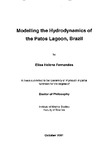Modelling the Hydrodynamics of the Patos Lagoon, Brazil
| dc.contributor.author | Fernandes, Elisa Helena | |
| dc.contributor.other | Faculty of Science and Engineering | en_US |
| dc.date.accessioned | 2013-09-16T10:43:35Z | |
| dc.date.available | 2013-09-16T10:43:35Z | |
| dc.date.issued | 2001 | |
| dc.identifier | NOT AVAILABLE | en_US |
| dc.identifier.uri | http://hdl.handle.net/10026.1/1744 | |
| dc.description | Merged with duplicate record 10026.1/679 on 13.20.2017 by CS (TIS) | |
| dc.description.abstract |
The Patos Lagoon, the largest choked coastal lagoon in the world, is a typical centre of population, commerce, industry and recreation, and consequently it is also a site for disposal of industrial, agricultural and municipal wastes. Important questions concerning beneficial uses of and potential changes to the lagoon and its estuary are left unanswered without a good understanding of hydrodynamic processes. The current study involves the choice, calibration and application of a numerical model which can be used in future hydrodynamic. sediment transport and water quality studies in the area. The two- and three-dimensional modes of the TELEMAC System were chosen to study the hydrodynamics of the Patos Lagoon. In order to calibrate the TELEMAC-2D model for the lagoon, measurements of salinity, current speed and direction, water elevation and wind speed and direction were carried out simultaneously at three stations in the estuarine area during three days. The model validation was carried out against an independent data set from the 1998 El Nino event. Several two-dimensional simulations were carried out to investigate the main processes controlling the Patos Lagoon hydrodynamics. The model was forced with prescribed river inflow at the top of the lagoon, wind stress at the surface and water elevation at the ocean boundary. The barotropic pressure gradients established between the lagoon and the coastal area as a result of local and remote wind combined with the freshwater discharge, proved to be the main forces controlling the lagoon subtidal circulation, as well as the exchanges between the lagoon and the coast. The local wind dominates the lagoon circulation through the set-up/set-down mechanism of oscillation, whereas the non-local wind drives the circulation in the lower estuary. The entrance channel acts as a filter and strongly reduces tidal and subtidal oscillations generated offshore. Three-dimensional simulations proved to be essential. Studies of the processes involved in the estuarine transverse circulation showed that the wind drives the lateral flow in the shallow areas, whereas in the channel it depends on lateral pressure gradients and channel curvature and geometry. Insights on the estuarine baroclinic circulation indicate the barotropic forces as the main mechanism controlling salt water penetration and salinity structure in the estuary. This study produced valuable information into the forces controlling the circulation of the Patos Lagoon and its estuary. Important issues regarding the capabilities of the TELEMAC System two and three-dimensional modules were explored, producing a valuable tool for further hydrodynamic and sediment transport numerical modelling experiments. | en_US |
| dc.language.iso | en | en_US |
| dc.publisher | University of Plymouth | en_US |
| dc.title | Modelling the Hydrodynamics of the Patos Lagoon, Brazil | en_US |
| dc.type | Thesis | |
| plymouth.version | Full version | en_US |
| dc.identifier.doi | http://dx.doi.org/10.24382/4288 |
Files in this item
This item appears in the following Collection(s)
-
01 Research Theses Main Collection
Research Theses Main


